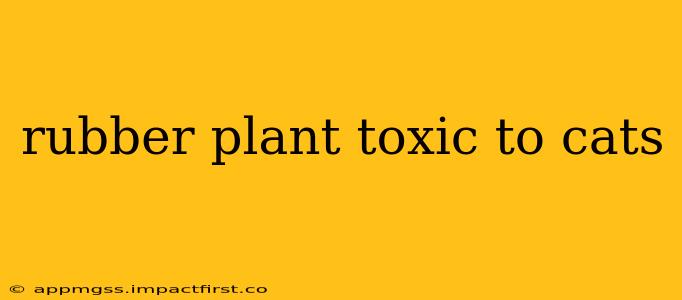The rubber plant, scientifically known as Ficus elastica, is a popular houseplant prized for its glossy leaves and relatively low-maintenance nature. However, for cat owners, the question of its toxicity is paramount. The short answer is yes, rubber plants are toxic to cats, but understanding the extent of the toxicity and how to mitigate the risk is crucial. This guide will delve into the specifics, addressing common concerns and providing practical advice.
How Toxic is a Rubber Plant to Cats?
Rubber plants contain calcium oxalate crystals. These crystals are irritating and can cause a range of unpleasant symptoms if ingested by cats. The toxicity isn't usually life-threatening, but it can cause significant discomfort and require veterinary attention. The severity of the reaction depends on the amount of plant material ingested.
What Happens if My Cat Eats a Rubber Plant?
If your cat ingests part of a rubber plant, you might observe the following symptoms:
- Oral Irritation: This is the most common symptom, characterized by excessive drooling, pawing at the mouth, and vocalization. The sharp crystals irritate the mouth and throat.
- Vomiting: Your cat may vomit as a natural response to the irritation and to try and expel the foreign substance.
- Difficulty Swallowing: The swelling caused by the crystals can make swallowing painful and difficult.
- Loss of Appetite: Discomfort in the mouth and throat can lead to a decrease in appetite.
In severe cases, you might also see:
- Swelling of the Tongue and Lips: Significant inflammation can occur in the oral cavity.
- Difficulty Breathing: In rare instances, severe swelling can affect the airway, making breathing difficult. This requires immediate veterinary attention.
What Should I Do if My Cat Eats a Rubber Plant?
Immediate Action is Key:
- Remove any remaining plant material from your cat's reach. Prevent further ingestion.
- Contact your veterinarian or a pet poison control center immediately. They can provide guidance based on your cat's size, the amount of plant material ingested, and the severity of the symptoms.
- Do NOT induce vomiting unless instructed by your vet or a poison control center. This can sometimes cause more harm than good.
- Observe your cat closely. Monitor for any changes in behavior or worsening symptoms.
Are All Parts of the Rubber Plant Toxic to Cats?
All parts of the rubber plant, including the leaves, stems, and sap, contain calcium oxalate crystals and are considered toxic to cats. Even a small amount can cause irritation.
What are the Treatments for Rubber Plant Poisoning in Cats?
Treatment will depend on the severity of the symptoms. Your veterinarian may recommend:
- Supportive Care: This often involves managing symptoms like pain and inflammation.
- Fluid Therapy: Intravenous fluids may be necessary to prevent dehydration, especially if your cat is vomiting.
- Pain Medication: Pain relievers can help alleviate discomfort.
- Anti-inflammatory Medications: These can reduce swelling and inflammation.
How Can I Prevent My Cat from Eating My Rubber Plant?
Prevention is always better than cure. Here are some effective strategies:
- Keep the plant out of reach: Place the rubber plant in a room your cat doesn't usually access, or on a high shelf.
- Use deterrents: Some cats are deterred by citrus scents. You can try placing orange or lemon peels near the plant.
- Provide alternative attractions: Offer your cat plenty of safe and engaging toys and scratching posts to distract them.
- Train your cat: Positive reinforcement training can teach your cat to avoid the plant.
Are there any non-toxic alternatives to rubber plants?
Yes, there are many beautiful and safe alternatives for cat owners. Some non-toxic options include spider plants, prayer plants, and Christmas cactus. Always research the safety of any plant before bringing it into a home with pets.
This information is for educational purposes only and does not constitute veterinary advice. If your cat ingests a rubber plant or shows any signs of illness, consult your veterinarian immediately. Early intervention is crucial for the best outcome.
